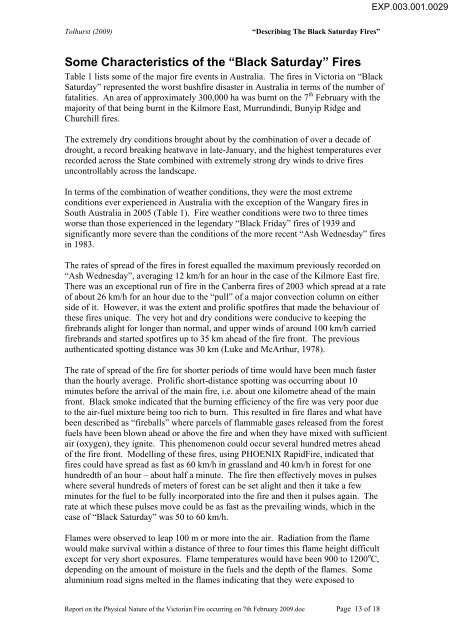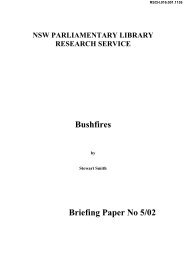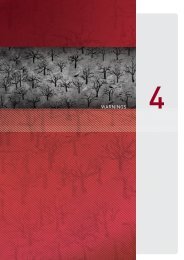Report on the Physical Nature of the Victorian Fires occurring on 7th ...
Report on the Physical Nature of the Victorian Fires occurring on 7th ...
Report on the Physical Nature of the Victorian Fires occurring on 7th ...
Create successful ePaper yourself
Turn your PDF publications into a flip-book with our unique Google optimized e-Paper software.
EXP.003.001.0029<br />
Tolhurst (2009)<br />
“Describing The Black Saturday <strong>Fires</strong>”<br />
Some Characteristics <strong>of</strong> <strong>the</strong> “Black Saturday” <strong>Fires</strong><br />
Table 1 lists some <strong>of</strong> <strong>the</strong> major fire events in Australia. The fires in Victoria <strong>on</strong> “Black<br />
Saturday” represented <strong>the</strong> worst bushfire disaster in Australia in terms <strong>of</strong> <strong>the</strong> number <strong>of</strong><br />
fatalities. An area <strong>of</strong> approximately 300,000 ha was burnt <strong>on</strong> <strong>the</strong> 7 th February with <strong>the</strong><br />
majority <strong>of</strong> that being burnt in <strong>the</strong> Kilmore East, Murrundindi, Bunyip Ridge and<br />
Churchill fires.<br />
The extremely dry c<strong>on</strong>diti<strong>on</strong>s brought about by <strong>the</strong> combinati<strong>on</strong> <strong>of</strong> over a decade <strong>of</strong><br />
drought, a record breaking heatwave in late-January, and <strong>the</strong> highest temperatures ever<br />
recorded across <strong>the</strong> State combined with extremely str<strong>on</strong>g dry winds to drive fires<br />
unc<strong>on</strong>trollably across <strong>the</strong> landscape.<br />
In terms <strong>of</strong> <strong>the</strong> combinati<strong>on</strong> <strong>of</strong> wea<strong>the</strong>r c<strong>on</strong>diti<strong>on</strong>s, <strong>the</strong>y were <strong>the</strong> most extreme<br />
c<strong>on</strong>diti<strong>on</strong>s ever experienced in Australia with <strong>the</strong> excepti<strong>on</strong> <strong>of</strong> <strong>the</strong> Wangary fires in<br />
South Australia in 2005 (Table 1). Fire wea<strong>the</strong>r c<strong>on</strong>diti<strong>on</strong>s were two to three times<br />
worse than those experienced in <strong>the</strong> legendary “Black Friday” fires <strong>of</strong> 1939 and<br />
significantly more severe than <strong>the</strong> c<strong>on</strong>diti<strong>on</strong>s <strong>of</strong> <strong>the</strong> more recent “Ash Wednesday” fires<br />
in 1983.<br />
The rates <strong>of</strong> spread <strong>of</strong> <strong>the</strong> fires in forest equalled <strong>the</strong> maximum previously recorded <strong>on</strong><br />
“Ash Wednesday”, averaging 12 km/h for an hour in <strong>the</strong> case <strong>of</strong> <strong>the</strong> Kilmore East fire.<br />
There was an excepti<strong>on</strong>al run <strong>of</strong> fire in <strong>the</strong> Canberra fires <strong>of</strong> 2003 which spread at a rate<br />
<strong>of</strong> about 26 km/h for an hour due to <strong>the</strong> “pull” <strong>of</strong> a major c<strong>on</strong>vecti<strong>on</strong> column <strong>on</strong> ei<strong>the</strong>r<br />
side <strong>of</strong> it. However, it was <strong>the</strong> extent and prolific spotfires that made <strong>the</strong> behaviour <strong>of</strong><br />
<strong>the</strong>se fires unique. The very hot and dry c<strong>on</strong>diti<strong>on</strong>s were c<strong>on</strong>ducive to keeping <strong>the</strong><br />
firebrands alight for l<strong>on</strong>ger than normal, and upper winds <strong>of</strong> around 100 km/h carried<br />
firebrands and started spotfires up to 35 km ahead <strong>of</strong> <strong>the</strong> fire fr<strong>on</strong>t. The previous<br />
au<strong>the</strong>nticated spotting distance was 30 km (Luke and McArthur, 1978).<br />
The rate <strong>of</strong> spread <strong>of</strong> <strong>the</strong> fire for shorter periods <strong>of</strong> time would have been much faster<br />
than <strong>the</strong> hourly average. Prolific short-distance spotting was <strong>occurring</strong> about 10<br />
minutes before <strong>the</strong> arrival <strong>of</strong> <strong>the</strong> main fire, i.e. about <strong>on</strong>e kilometre ahead <strong>of</strong> <strong>the</strong> main<br />
fr<strong>on</strong>t. Black smoke indicated that <strong>the</strong> burning efficiency <strong>of</strong> <strong>the</strong> fire was very poor due<br />
to <strong>the</strong> air-fuel mixture being too rich to burn. This resulted in fire flares and what have<br />
been described as “fireballs” where parcels <strong>of</strong> flammable gases released from <strong>the</strong> forest<br />
fuels have been blown ahead or above <strong>the</strong> fire and when <strong>the</strong>y have mixed with sufficient<br />
air (oxygen), <strong>the</strong>y ignite. This phenomen<strong>on</strong> could occur several hundred metres ahead<br />
<strong>of</strong> <strong>the</strong> fire fr<strong>on</strong>t. Modelling <strong>of</strong> <strong>the</strong>se fires, using PHOENIX RapidFire, indicated that<br />
fires could have spread as fast as 60 km/h in grassland and 40 km/h in forest for <strong>on</strong>e<br />
hundredth <strong>of</strong> an hour – about half a minute. The fire <strong>the</strong>n effectively moves in pulses<br />
where several hundreds <strong>of</strong> meters <strong>of</strong> forest can be set alight and <strong>the</strong>n it take a few<br />
minutes for <strong>the</strong> fuel to be fully incorporated into <strong>the</strong> fire and <strong>the</strong>n it pulses again. The<br />
rate at which <strong>the</strong>se pulses move could be as fast as <strong>the</strong> prevailing winds, which in <strong>the</strong><br />
case <strong>of</strong> “Black Saturday” was 50 to 60 km/h.<br />
Flames were observed to leap 100 m or more into <strong>the</strong> air. Radiati<strong>on</strong> from <strong>the</strong> flame<br />
would make survival within a distance <strong>of</strong> three to four times this flame height difficult<br />
except for very short exposures. Flame temperatures would have been 900 to 1200 o C,<br />
depending <strong>on</strong> <strong>the</strong> amount <strong>of</strong> moisture in <strong>the</strong> fuels and <strong>the</strong> depth <strong>of</strong> <strong>the</strong> flames. Some<br />
aluminium road signs melted in <strong>the</strong> flames indicating that <strong>the</strong>y were exposed to<br />
<str<strong>on</strong>g>Report</str<strong>on</strong>g> <strong>on</strong> <strong>the</strong> <strong>Physical</strong> <strong>Nature</strong> <strong>of</strong> <strong>the</strong> <strong>Victorian</strong> Fire <strong>occurring</strong> <strong>on</strong> <strong>7th</strong> February 2009.doc Page 13 <strong>of</strong> 18

















